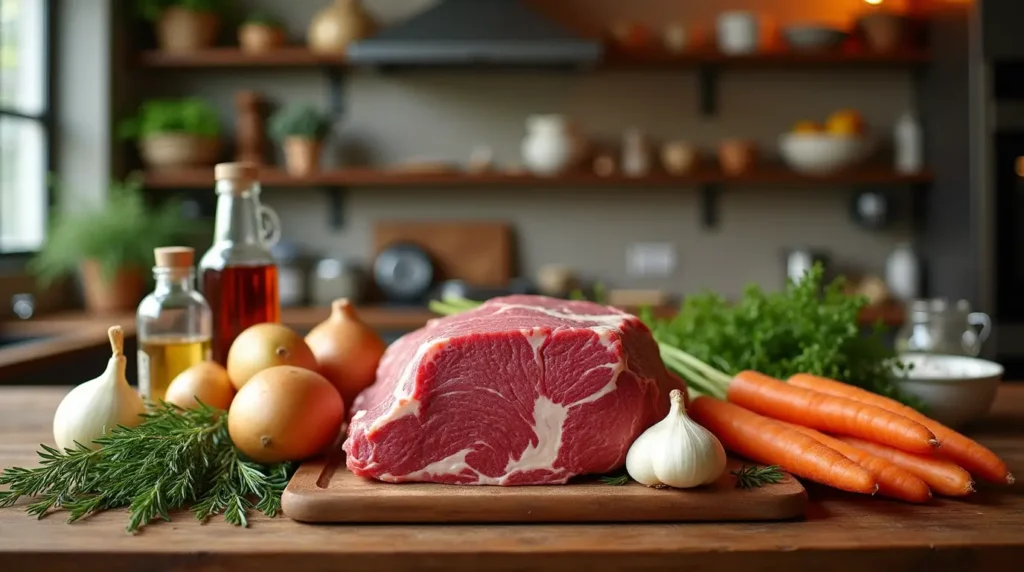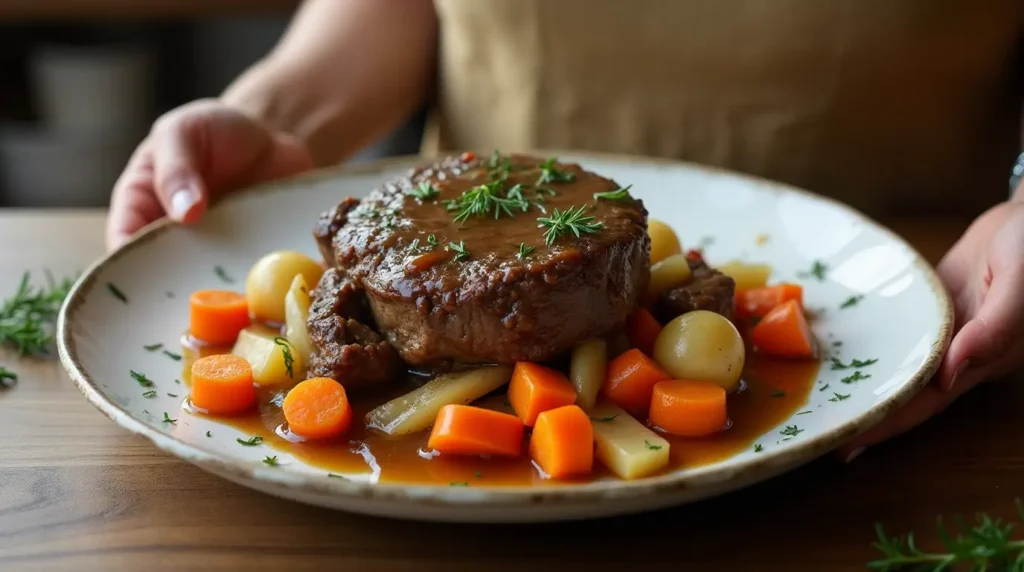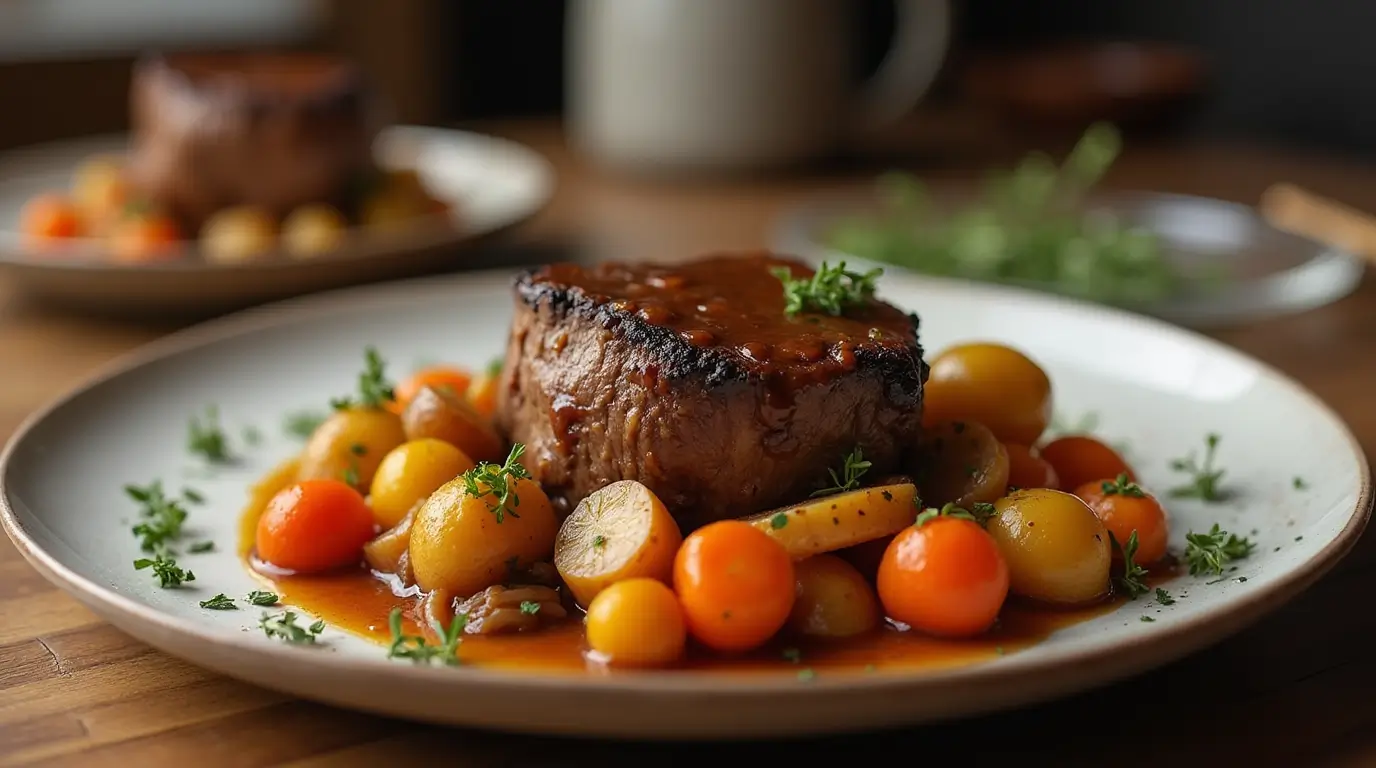There’s something uniquely comforting about a hearty pot roast for one—its rich, savory flavors and tender meat can turn any meal into a cozy occasion. When you don’t need to cook for a crowd but still crave that homestyle goodness, a perfectly portioned pot roast for one is exactly what you need. Whether it’s a weeknight dinner or a special solo treat, this recipe delivers all the flavors of a classic pot roast without any leftovers.
This pot roast for one recipe is incredibly satisfying. You get the depth of flavor and tenderness you desire in every bite, all without the hassle of preparing an entire roast for a large group. It’s easy to make, filled with rich herbs and seasonings, and perfect for anyone looking to enjoy a fulfilling meal, just for themselves.
Introduction
Cooking for one can sometimes feel like a daunting task, especially when you’re craving something hearty and filling like a pot roast. Typically a dish associated with family dinners or large gatherings, the traditional pot roast seems impractical for a solo meal. But what if you could enjoy all the deliciousness of a classic pot roast without the need for leftovers or a full-sized roast? This recipe offers that perfect solution, delivering a perfectly cooked, tender roast that fits comfortably into your lifestyle.
This single-serve pot roast is a game changer for those who want the satisfaction of a comforting meal without any waste. It takes the essence of the classic dish and reimagines it for one, so you can indulge in a hearty, slow-cooked meal on your terms. Plus, it’s easy to prepare, requiring only a few simple steps and ingredients you likely already have in your kitchen. Whether it’s a chilly evening or a special treat to yourself, this pot roast is sure to become a go-to recipe.
Table of Contents
Key Takeaways
- This Pot Roast for One recipe is all about bringing the classic pot roast experience to a single serving.
- Expect tender, juicy meat infused with a flavorful blend of herbs and seasonings, paired with perfectly cooked vegetables.
- The recipe is simple, requires minimal preparation, and is perfect for anyone looking for a quick, satisfying meal.
- Suitable for a variety of dietary preferences, this dish can easily be made gluten-free by adjusting the gravy.
- The recipe offers flexibility with the choice of meat and side dishes, making it adaptable to different tastes.
Recipe Card
| Prep Time | Cook Time | Total Time | Servings | Calories per Serving |
|---|---|---|---|---|
| 10 minutes | 1 hour 30 minutes | 1 hour 40 minutes | 1 | 500 kcal |
Ingredients
| Ingredient | Quantity | Notes |
|---|---|---|
| Beef chuck roast | 6 oz (approx.) | Bone-in or boneless, depending on preference |
| Carrots | 1 medium | Peeled and cut into chunks |
| Onion | 1/2 medium | Sliced |
| Potatoes | 2 small | Peeled and diced |
| Garlic | 2 cloves | Minced |
| Beef broth | 1 cup | Low-sodium preferred |
| Olive oil | 1 tbsp | For searing meat |
| Fresh thyme | 1 sprig | Can substitute with dried thyme |
| Fresh rosemary | 1 sprig | Can substitute with dried rosemary |
| Salt | To taste | Adjust to preference |
| Black pepper | To taste | Adjust to preference |
| Bay leaf | 1 | Optional, for extra flavor |
| Flour (optional) | 1 tbsp | For thickening gravy |

Step-by-Step Recipe Instructions for Pot Roast For One
Step 1: Brown the Roast
Instructions:
- Start by heating the olive oil in a large skillet or Dutch oven over medium-high heat.
- Season your beef chuck roast generously with salt and pepper on both sides.
- When the oil is hot, carefully add the roast to the pan. Sear it for about 3-4 minutes per side until a golden brown crust forms. This step locks in the flavors and juices.
Tip: If the roast sticks to the pan, don’t force it. Let it naturally release as it browns, ensuring a perfect sear.
Step 2: Add Vegetables and Broth
Instructions:
- After the roast is seared, remove it from the skillet and set it aside.
- In the same pan, add the onions, carrots, and potatoes. Stir them around to coat them in the remaining oil and fond (the browned bits left from the meat).
- Add the garlic and cook for another minute.
- Pour in the beef broth, scraping the bottom of the pan to release any remaining fond. This will add incredible depth of flavor to your dish.
Tip: If you prefer a thicker sauce, sprinkle a little flour into the broth and stir well to prevent lumps.
Step 3: Slow Cook the Roast
Instructions:
- Return the roast to the skillet, nestling it in between the vegetables.
- Add the fresh thyme, rosemary, and bay leaf (if using). Cover the skillet with a lid.
- Reduce the heat to low and let everything cook gently for 1-1.5 hours, or until the roast is fork-tender. This slow-cooking method ensures that the meat becomes melt-in-your-mouth tender and infused with the herb flavors.
Tip: If you have a slow cooker, you can transfer everything into the slow cooker after searing the meat and let it cook on low for 4-6 hours for even more tenderness.
Step 4: Make the Gravy
Instructions:
- Once the roast is done, carefully remove the meat from the skillet. Allow the roast to rest for about 5 minutes before cutting into it.
- For a thicker gravy, remove the vegetables and whisk a tablespoon of flour into the remaining liquid. Allow it to cook for a few minutes until thickened to your liking.
Tip: If the gravy is too thick, add a bit more beef broth to achieve your desired consistency.
Step 5: Serve
Instructions:
- Slice the pot roast and serve it alongside the tender vegetables, topped with the rich gravy.
Tip: If you’re feeling indulgent, serve this dish with a side of crusty bread to soak up any remaining gravy!
Notes
- Meat Options: While beef chuck is a classic choice, you can use other cuts like beef brisket or round roast for a slightly different flavor and texture. If you prefer a leaner cut, a sirloin or tenderloin can also work.
- Vegetables: Feel free to add other vegetables such as parsnips or mushrooms for more variety. Just be sure to adjust cooking times based on the type of vegetable.
- Gravy Consistency: If you prefer a thinner gravy, simply skip the flour thickening step or add less flour. For an even richer gravy, consider using a mix of beef and chicken broth.
- Flavor Boost: For an extra punch of flavor, you can deglaze the pan with a splash of red wine after searing the roast, adding complexity to the broth.
Nutrition Information
| Nutrient | Amount per Serving |
|---|---|
| Calories | 500 kcal |
| Total Fat | 18g |
| Saturated Fat | 7g |
| Cholesterol | 80mg |
| Sodium | 500mg |
| Total Carbohydrates | 34g |
| Dietary Fiber | 6g |
| Sugars | 5g |
| Protein | 45g |
Tools and Equipment Needed
| Equipment | Purpose |
|---|---|
| Dutch oven or skillet | For searing the meat and slow cooking |
| Cutting board | To chop vegetables and prepare the roast |
| Knife | For slicing vegetables and the roast |
| Measuring spoons | To measure seasonings and flour (if used) |
| Tongs or spatula | To flip the roast during searing |
The History of Pot Roast
Pot roast has long been a staple of American home cooking, dating back to the early 19th century. Its origins can be traced to the Dutch settlers in New York, who introduced the technique of braising tough cuts of meat in a pot with vegetables and liquids. This method was used to make cheaper cuts of beef tender and flavorful. Over time, pot roast became a popular dish in households across the United States, often seen as the centerpiece of a Sunday family meal. Its humble beginnings as a way to stretch a meal for many have contributed to its lasting appeal, and it remains a comforting favorite to this day.
As the dish evolved, regional variations emerged, with different types of meat and vegetables added depending on local tastes and available ingredients. Pot roast became a versatile dish, loved by many for its simplicity and heartiness. Today, it’s still a go-to comfort food, celebrated for its rich flavors and easy preparation. Whether made in a slow cooker, Dutch oven, or stovetop, the essence of pot roast has remained the same—slow-cooked tenderness in a savory, aromatic broth.

Common Mistakes to Avoid
One common mistake when preparing pot roast is overcooking the meat. While slow cooking ensures tenderness, if left on the heat for too long, the meat can become dry or too mushy. To avoid this, be sure to check the roast for tenderness after the recommended cooking time. If you’re using a slow cooker, be mindful of the cooking time, as it may vary based on the cut of meat.
Another common pitfall is not properly searing the meat. Skipping the browning step can result in a less flavorful dish. Searing the roast creates a caramelized crust that enhances the overall flavor of the pot roast. Additionally, some may overlook the importance of seasoning. Properly seasoning the meat and broth ensures that every component of the dish is flavorful, rather than bland. Don’t forget to taste and adjust the seasoning as you go.
Why You’ll Love This Recipe
- Flavor Profile: This pot roast offers a rich, savory flavor with hints of herbs like thyme and rosemary, complemented by the sweetness of carrots and onions. The slow-cooked broth provides a deep, umami taste that makes every bite satisfying.
- Ease of Preparation: This recipe is simple and requires minimal hands-on time. Once the roast is seared and the ingredients are added to the pot, the dish essentially cooks itself, allowing you to relax while it comes together.
- Versatility: Pot roast for one is adaptable to a wide range of dietary preferences and can be paired with different sides or flavors to suit your taste. Whether you prefer a hearty potato mash or roasted vegetables, it can be customized to match any occasion.
Key Ingredients and Substitutions
The key ingredients in this recipe—beef chuck roast, vegetables, herbs, and broth—come together to create a deliciously comforting dish. The beef chuck is known for its rich flavor and tender texture when cooked slowly, but it can be substituted with other cuts such as brisket or round roast if desired.
For those with dietary restrictions, the recipe can be made gluten-free by omitting the flour used for thickening the gravy or substituting it with cornstarch. Additionally, if you prefer a lower-sodium option, you can use low-sodium broth and adjust the seasoning accordingly. Vegetables such as parsnips or mushrooms can be used instead of potatoes for a different twist, or even to add more variety.
Culinary Magic: The Pleasure of Making This Recipe
There’s something magical about watching the roast slowly cook, filling your home with the savory aromas of the herbs, vegetables, and tender meat. The process allows flavors to develop fully, creating a dish that’s greater than the sum of its parts. As you follow each step, you’ll see how the heat transforms the ingredients, melding them into a flavorful, comforting meal that brings joy with every bite.
Troubleshooting Common Issues
Problem: The roast turned out tough.
Solution: If your roast is tough, it likely wasn’t cooked long enough. Pot roast requires slow cooking to break down the tough fibers of the meat. Try cooking it longer at a low temperature to achieve the desired tenderness.
Problem: The gravy is too thin.
Solution: To thicken the gravy, mix a tablespoon of flour or cornstarch with a little cold water, then whisk it into the cooking liquid. Simmer the mixture until it reaches your desired thickness.
Expert Tips for Success
- Searing the Meat: For the best flavor, don’t rush the searing process. Allow the roast to brown properly, as this caramelization adds a deep, rich flavor to the dish.
- Use Fresh Herbs: While dried herbs can be used, fresh rosemary and thyme provide a more vibrant and aromatic flavor. Be sure to remove the herbs before serving to avoid any tough, inedible stems.
- Cook Low and Slow: The secret to a tender pot roast is slow cooking. Whether you’re using the stovetop, oven, or slow cooker, low and slow is the key to achieving the perfect melt-in-your-mouth texture.
Variations and Customizations
- Vegan Option: To make this recipe vegan, substitute the beef with a hearty vegetable like portobello mushrooms or seitan. Use vegetable broth in place of beef broth and skip the meat searing step.
- Spice it Up: For a bit of heat, add a pinch of cayenne pepper or red pepper flakes to the broth for a subtle kick. You can also include a dash of smoked paprika for a smoky depth of flavor.
Storing Leftovers (Refrigeration/Freezing)
If you have leftovers, store them in an airtight container in the refrigerator for up to 3 days. For extended storage, freeze the pot roast in a freezer-safe container for up to 3 months. When reheating, it’s best to use the stovetop or oven rather than a microwave to maintain the texture of the meat and vegetables. Simply heat the roast and gravy over low heat until warmed through, adding a bit more broth if necessary.
Tips for Reheating: When reheating, keep the pot roast covered to retain moisture, and avoid cooking it too long. Overheating can cause the meat to dry out, so reheat just until warm and serve immediately.
Serving Suggestions
To complement your pot roast, serve it with a side of mashed potatoes, buttered noodles, or roasted Brussels sprouts. A simple green salad with a tangy vinaigrette will provide a refreshing contrast to the rich flavors of the roast. Pair your meal with a glass of red wine, such as a Cabernet Sauvignon or Merlot, which complements the hearty, savory flavors of the pot roast. For dessert, a warm apple crisp or chocolate cake would make a delightful finish to your comforting meal.
Frequently Asked Questions
How can I make this pot roast recipe gluten-free?
To make this recipe gluten-free, simply omit the flour used for thickening the gravy or replace it with a gluten-free thickener, such as cornstarch or arrowroot powder. Be sure to use a gluten-free beef broth as well, as some broths may contain gluten.
Is it possible to use a different cut of meat for this recipe?
Yes, you can substitute the beef chuck roast with other cuts of meat, such as brisket or round roast. These cuts may require slightly different cooking times, so be sure to check for tenderness as you cook. If you prefer a leaner roast, sirloin or tenderloin can also be used, though they may not be as tender as the chuck roast.
Can I cook the pot roast in a slow cooker instead of on the stovetop?
Yes, you can cook this pot roast in a slow cooker. After searing the meat and sautéing the vegetables, transfer everything to your slow cooker and cook on low for 4-6 hours or until the meat is fork-tender. Just be sure to check the seasoning halfway through the cooking process to adjust to taste.
Can I make this recipe in advance?
Pot roast can be prepared in advance! After cooking, allow the pot roast to cool to room temperature, then store it in an airtight container in the refrigerator for up to 3 days. You can also freeze the leftovers for up to 3 months. When reheating, be sure to add a bit of beef broth to keep the meat moist.
What’s the best way to adjust the thickness of the gravy?
To adjust the thickness of the gravy, simply control the amount of flour or cornstarch you use. For a thicker gravy, use more flour or cornstarch and let it simmer longer. For a thinner gravy, use a less thickening agent or skip it altogether. You can also add additional broth or water to thin it out as needed.
Related Recipes
If you enjoyed making this pot roast for one, you might also love these other comforting, hearty dishes that cater to both small and larger gatherings:
- Beef Stew for One – A savory, filling stew with tender chunks of beef, root vegetables, and a rich broth, perfect for a cozy dinner.
- Braised Short Ribs – These tender, fall-off-the-bone short ribs are cooked low and slow for a melt-in-your-mouth experience, offering similar flavors to pot roast with a slightly different texture.
- Slow Cooker Beef and Vegetable Soup – A warm, nourishing soup that combines beef, vegetables, and a savory broth, ideal for a quick meal when you want something easy and satisfying.
- Single-Serve Meatloaf – A personal-sized meatloaf that’s both comforting and easy to prepare, with a savory glaze and tender interior.
Conclusion: A Delicious Intersection of Tradition and Modernity
Pot roast for one strikes the perfect balance between tradition and modern convenience. This dish, steeped in history, brings together the time-honored method of slow cooking with the practicality of a portion-sized recipe, making it an ideal choice for a satisfying solo meal. It’s easy to prepare, full of flavor, and adaptable to various tastes, ensuring that anyone can enjoy it.
By preparing this recipe, you’re not only creating a delicious dish but also embracing a tradition that has been cherished for generations. Whether you’re cooking for yourself or sharing it with loved ones, this pot roast brings a hearty, comforting meal to your table. We encourage you to try it out, experiment with your variations, and savor every bite!
Call to Action
Ready to make this delicious Pot Roast for One? Give it a go and share with us how it turns out! We’d love to hear about your twists, tips, and serving ideas in the comments below. Don’t forget to share your experience—whether it’s your choice of herbs, a unique side dish, or how you customized the recipe to suit your tastes! If you’re looking for more meal ideas or variations on this classic, we invite you to explore other recipes on our site. Your feedback not only helps others discover new ideas but also inspires us to keep creating more satisfying meals for you to enjoy. Happy cooking!

